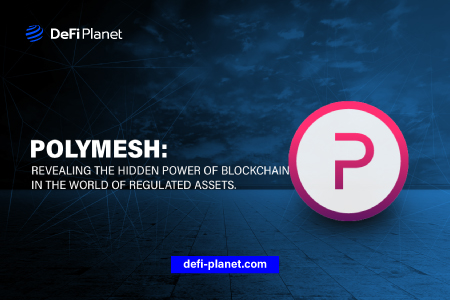The application of blockchain technology has expanded beyond the cryptocurrency market and found utility in asset tokenization, particularly for real-world assets like securities.
However, as the asset tokenization market continues to grow(currently valued at $2.28 billion) and is projected to reach trillions of dollars in the coming years, the need for blockchain networks compatible with regulatory frameworks in the industry has become evident.
Existing popular blockchain networks, though sophisticated, lack seamless compatibility with the requirements of regulated assets and investment industries. These networks were not initially designed to align with regulatory frameworks; thus, there is a gap between blockchain technology and the securities industry.
The Polymesh blockchain is positioned to bridge this gap. It is a tailored foundational architecture specific to securities representation. Polymesh is designed as a robust system that addresses compliance, identity verification, confidentiality, and other critical aspects of the securities market.
This article provides a comprehensive exploration of the Polymesh blockchain, delving into the motives driving its development, highlighting its key features, and examining its potential outlook for the future.
What is Polymesh?
Polymesh is an enterprise-level blockchain network designed specifically for storing and transferring regulated assets on the blockchain.
Unlike general-purpose blockchains like Ethereum, Polymesh focuses on addressing the issue of representing traditional assets (e.g., securities) on the blockchain. Its primary purpose is to enable the creation of on-chain representations for regulated assets.
Polymesh is developed by the same team behind Polymath, a project built on the Ethereum blockchain for issuing security tokens on-chain.While the Polymath team has benefited from Ethereum’s security and broad use cases, they recognized that Ethereum’s lack of specialization in providing on-chain representation for regulated assets was a limitation.
Furthermore, public blockchains like Ethereum lack the necessary features for compliance in regulated industries. For example, Ethereum’s emphasis on decentralization and anonymity makes it less suitable for industries like securities, where verifiable identity is crucial.
Polymesh addresses these shortcomings to better serve the needs of regulated environments. While it operates as a public blockchain like Ethereum, Polymesh is permissioned to ensure compliance and regulatory requirements are met.
The Polymesh blockchain is an open-source project that allows external contributors to access and modify it. The Polymesh Association, a non-profit organization based in Switzerland, manages and develops Polymesh.
It operates under Swiss laws and ensures that the Polymesh network functions and the issuance of security tokens comply with Swiss regulations.
Polymesh’s genesis block went live on October 28, 2021.
What Is Polymesh Built For?
Here are the key objectives and benefits that Polymesh aims to provide:
- Improved Accessibility and Liquidity: Polymesh focuses on creating security tokens to enhance accessibility and liquidity for investors. By leveraging blockchain technology, Polymesh simplifies investor access to securities, making it easier for them to participate in the market. This introduces a new stream of liquidity, increasing market efficiency.
- Streamlined Regulatory Compliance: Polymesh streamlines regulatory compliance for securities. It provides a robust framework that simplifies monitoring, reporting, and auditing processes. By utilizing blockchain’s transparency and immutability, Polymesh ensures data integrity, making it difficult to manipulate or tamper with. This reduces the reliance on traditional paperwork and streamlines compliance procedures.
- Cost-effective Reporting and Auditing: The Polymesh network offers a cost-effective solution for reporting and auditing securities. By digitizing these processes on the blockchain, it eliminates the need for lengthy paperwork and inefficient back-and-forth between various stakeholders. The blockchain’s accessibility enables real-time access to data, reducing administrative overhead and enhancing efficiency.
- Enhanced Security and Trust: Polymesh leverages the inherent security features of blockchain technology to provide a trusted environment for regulated assets. By design, the blockchain ensures that transactions and data recorded on Polymesh are secure, transparent, and tamper-resistant. This instills trust among participants, fostering a more reliable ecosystem for securities.
Polymesh’s Key Pillars
Polymesh is built on four key pillars to address the unique requirements of regulated assets. Let’s explore these in detail:
Compliance
Polymesh incorporates compliance features to enforce regulatory requirements. This includes mechanisms for investor whitelisting and restrictions on token transfers to ensure that only eligible investors can hold and trade the security tokens on the network.
Identity
Public blockchain networks prioritize anonymity, which makes them unsuitable for securities regulation that requires proper validation of investors’ qualifications for specific investment classes.
In contrast, Polymesh ensures that all participants on its network undergo thorough verification to demonstrate their eligibility for their chosen roles within the network.
This verification process is designed to ensure compliance with regulatory requirements and validate the authenticity of participants on the Polymesh network.
Confidentiality
Polymesh addresses privacy concerns associated with on-chain data accessibility by prioritizing investor confidentiality. Despite being a public blockchain, Polymesh provides a controlled environment where sensitive information remains protected. This confidentiality feature makes it suitable for asset management and the securities industry, where privacy is crucial.
Governance
Polymesh implements a unified governance process to prevent network separation (forks). This ensures the blockchain’s security is not affected by asset splits across different networks. The network is governed by well-structured management processes, providing stability and cohesion for issuers, investors, and regulators.
Settlement
Polymesh introduces a distinctive transaction settlement mechanism. Unlike traditional systems where settlement is solely determined by the account authorizing the transaction, Polymesh requires the receiving account to actively accept or reject an asset transfer. This mechanism prevents accounts from incurring unnecessary tax liabilities for receiving random airdrops that they may have declined if given the choice.
The Polymesh Ecosystem
Polymesh takes inspiration from Ethereum while introducing its own unique features. Let’s explore some key components of the Polymesh ecosystem:
Polymesh Smart Extensions
While many blockchain networks rely on smart contracts to enforce predefined conditions, Polymesh takes a different approach by utilizing smart extensions. Smart extensions offer a more flexible and effective method for setting rules on the Polymesh network. These extensions can be used to encode regulatory procedures, asset distribution, and governance structures.
The Polymesh blockchain also supports the creation and utilization of smart contracts on its network.
Polymesh Nominated Proof-of-Stake (NPoS)
Polymesh uses a variation of the Proof-of-Stake (PoS) consensus mechanism known as Nominated Proof-of-Stake (NPoS). This consensus involves two key roles: validators and nominators.
Validators operate their own nodes and are responsible for verifying the validity of transactions on the network. They can determine whether a transaction has occurred correctly or not. Nominators, on the other hand, do not have the authority to verify transaction validity.
However, nominators can stake POLYX tokens (the native token of the Polymesh network) with validators of their choice. Validators earn additional POLYX token rewards for verifying transactions on the network, while nominators receive rewards proportional to their stake.
Validators are typically established and verified entities with permission to run validator nodes. Nominators, on the other hand, can be any network participant who holds the POLYX token. Nominators undergo KYC procedures to verify their identity and can nominate validators to secure the network and add new blocks.
The POLYX Token
POLYX is the native and utility token of the Polymesh network. Similar to Ethereum’s Ether (ETH), POLYX facilitates transactions within the Polymesh ecosystem. It serves the following purposes:
- Gas: Participants use POLYX to complete transactions on the network. Security token issuers require POLYX to authorize transactions for issuing security tokens, and investors can use POLYX to buy and transfer security tokens.
- Staking: POLYX token holders can stake their tokens to secure the Polymesh network. They can participate as either validators or nominators. Validators are trusted entities vetted by the Polymesh team, while any token holder can become a nominator by staking their tokens with the network’s validators.
- Governance: The POLYX token enables active participation in the governance of the Polymesh ecosystem. Holders can stake their POLYX tokens to vote on important decisions, such as network upgrades. This allows them to have a say in the governance process.
POLYX is regulated by the Swiss Financial Market Supervisory Authority (FINMA).
POLYX Token Economy
POLYX is an inflationary token without a maximum supply cap. Its circulating supply and inflation rate are influenced by factors like demand, supply, and network validation rewards. According to the project’s whitepaper, approximately 14% of the circulating POLYX tokens will be introduced annually. However, once the token supply reaches 1 billion, the yearly release of new tokens will be limited to 140 million POLYX.
At press time, Polymesh’s POLYX trades at $0.12, a significant decrease of 69% from its all-time high. The circulating supply of POLYX is 661,215,177 tokens, with a market cap of $81,217,285.
To securely hold POLYX tokens and other security tokens developed on the Polymesh blockchain, users need to create an account on the Polymesh wallet.
How Does Polymesh Work?
There are two main participants in the Polymesh Network: the issuers and investors. And to access the network, all these participants must complete identity verification following Know Your Customer/Anti-Money Laundering (KYC/AML) requirements conducted by trusted third-party platforms. This ensures that only authorized users can join.
Once security token issuers pass the verification process, they can create on-chain representations of securities like shares, debt claims, and real estate.
Polymesh’s identity verification also helps confirm the authenticity of these assets on the blockchain. The issuers can encode specific rules, regulations, and maximum allocation per investor into smart extensions to ensure compliance throughout the lifecycle of the token.
Investors must also fulfill KYC requirements to access the network. If the conditions are met, they can search for security tokens that align with their requirements and execute transactions securely using smart extensions.
Polymesh vs Ethereum
Let’s compare the features and capabilities of an enterprise-grade blockchain like Polymesh with all-purpose blockchain networks like Ethereum.
Figure: Comparing Ethereum and Polymesh

Challenges Of The Polymesh Blockchain
Centralization
The Polymesh blockchain carries the risk of centralization due to the significant control exerted by the Polymesh team. They have authority over key aspects such as selecting validators and oracle networks, which reduces the potential for decentralization and increases the vulnerability of the network. With fewer validators, there is a higher risk of potential infiltration or manipulation within the network, posing potential security concerns.
Reduced Validator Quality On The Network
The strict compliance requirements of the Polymesh blockchain may deter experienced node operators with expertise in validating transactions on public networks from joining. This limitation reduces the quality of participating nodes responsible for validating the Polymesh blockchain, as it is limited to a select few.
In Conclusion,
- Polymesh offers a compelling solution for institutions seeking to represent securities on the blockchain. It offers scalability and regulatory compliance advantages over public blockchains like Ethereum.
- Polymesh also benefits from the years of experience of the Polymath team, the team that originally created Polymesh. This adds credibility and a commitment to success in the asset tokenization space.
- By targeting the $119 billion security market instead of competing directly with established all-purpose blockchain networks, Polymesh increases its chances of success.
- As the blockchain space continues to adapt to changing regulatory requirements, Polymesh is positioned to be one of the few public blockchains that can easily adjust to these demands. Its origins in regulatory compliance development give it a significant advantage in meeting the evolving needs of institutional participants.
Disclaimer: This article is intended solely for informational purposes and should not be considered trading or investment advice. Nothing herein should be construed as financial, legal, or tax advice. Trading or investing in cryptocurrencies carries a considerable risk of financial loss. Always conduct due diligence.
If you would like to read more articles like this, visit DeFi Planet and follow us on Twitter, LinkedIn, Facebook, Instagram, and CoinMarketCap Community.
“Take control of your crypto portfolio with MARKETS PRO, DeFi Planet’s suite of analytics tools.”





















